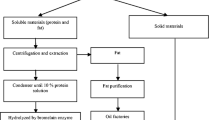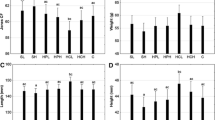Abstract
Potato protein concentrate (PPC) is a potential fish meal (FM) substitute. We replaced FM in greater amberjack diets with low-temperature air-dried PPC (LT-PPC) and high-temperature rotary-dried PPC (HT-PPC) to investigate their effects on growth and feed utilization. Four experimental and one control diet was prepared. The control diet comprised FM, wherein the experimental diets were prepared by replacing 20 and 40% of FM in the control diet with LT-PPC (LP20 and LP40) or HT-PPC (LP20 and LP40). Following an 8-week growth trial, the final mean body weight, specific growth rate, and feed intake of HP40 diet-fed fish were significantly lower than those of control diet-fed fish (p < 0.05). However, these parameters in LT-PPC and HP20 diet-fed fish did not differ significantly from those of the control diet-fed fish (p > 0.05). In vitro relative protein digestibility did not differ between LT-PPC (91.1%) and HT-PPC (89.5%) (p > 0.05); however, the digestion speed of LT-PPC was higher (63.8%) than that of HT-PPC (46.8%) (p < 0.05). In conclusion, the findings demonstrate that LT-PPC and HT-PPC could be used to replace up to 40 and 20% of FM in greater amberjack diets, respectively, without compromising growth performance.


Similar content being viewed by others
Data availability
The datasets generated and analyzed during the current study are available from the corresponding author upon reasonable request.
References
AOAC (1995) Official methods of analysis of AOAC international, 16th edn. Association of Official Analytical Chemists International, Washington DC
Bardach JE, Villars T (1974) The chemical sense of fishes. In: Grant PT, Mackie AM (eds) Chemoreception in Marine Organisms. Academic Press, London, pp 49–104
Barrows FT, Stone DAJ, Hardy RW (2007) The effects of extrusion conditions on the nutritional value of soybean meal for rainbow trout (Oncorhynchus mykiss). Aquaculture 265:244–252
Camire ME, Zhao J, Violette DA (1993) In vitro binding of bile acids by extruded potato peels. J Agric Food Chem 41:2391–2394
Fernández-Montero A, Caballero MJ, Torrecillas S, Tuset VM, Lombarte A, Ginés RR, Izquierdo M, Robaina L, Montero D (2018) Effect of temperature on growth performance of greater amberjack (Seriola dumerili Risso 1820) juveniles. Aquac Res 49:908–918
Furukawa A, Tsukahara H (1966) On the acid digestion method for the determination of chromic oxide as an index substance in the study of digestibility of fish feed. B Jpn Soc Sci Fish 32:502–506 (in Japanese with English abstract)
Gatlin DM, Barrows FT, Brown P, Dabrowski K, Gaylord TG, Hardy RW, Herman E, Hu G, Krogdahl Å, Nelson R, Overturf K, Rust M, Sealey W, Skonberg D, Souza EJ, Stone D, Wilson R, Wurtele E (2007) Expanding the utilization of sustainable plant products in aquafeeds: a review. Aquac Res 38:551–579
Gilani GS, Cockell KA, Sepehr E (2005) Effects of antinutritional factors on protein digestibility and amino acid availability in foods. J AOAC Int 88:967–987
Haque MA, Adhikari B (2015) Drying and denaturation of proteins in spray drying process. In: Mujumdar AS (ed) Handbook of Industrial Drying, 4th edn. CRC Press, Florida, pp 971–983
Hardy RW (2010) Utilization of plant proteins in fish diets: effects of global demand and supplies of fishmeal. Aquac Res 41:770–776
Hidaka I, Ohsugi T, Kubomatsu T (1978) Taste receptor stimulation and feeding behaver in the puffer, Fugu pardalis. I. Effect of single chemicals. Chem Senses 3:341–354
Jover M, García-Gómez A, Tomás A, Gándara FDL, Pérez L (1999) Growth of Mediterranean yellowtail (Seriola dumerili) fed extruded diets containing different levels of protein and lipid. Aquaculture 179:25–33
Kahlon TS, Woodruff CL (2002) In vitro binding of bile acids by soy protein, pinto beans, black beans and wheat gluten. Food Chem 79:425–429
Kiyohara S (1994) I-3. Gustatory receptor response. In: Harada K (ed) Chemical stimulants for feeding behavior of fish and shellfish. Kouseisya Kouseikaku Co., Ltd, Tokyo, pp 23–33
Kofuji PYM, Hosokawa H, Masumoto T (2006) Effects of dietary supplementation with feeding stimulants on yellowtail Seriola quinqueradiata (Temminck and Schlegel; Carangidae) protein digestion at low water temperatures. Aquac Res 37:366–373
Moyano FJ, Cardenete G, Higuera MDL (1992) Nutritive values of diets containing a high percentage of proteins for trout, Oncorhynchus mykiss. Aquat Living Resour 5:23–29
Olsen RL, Hasan MR (2012) A limited supply of fishmeal: impact on future increases in global aquaculture production. Trends Food Sci Technol 27:120–128
Ono S, Nakahara N (2009) Current conditions and issues in the fish aquaculture industry. Aquac Sci 57:149–164
Pastuszewska B, Tuśnio A, Taciak M, Mazurczyk W (2009) Variability in the composition of potato protein concentrate. Anim Feed Sci Tech 154:260–264
Refstie S, Tiekstra HAJ (2003) Potato protein concentrate with low content of solanidine glycoalkaloids in diets for Atlantic salmon (Salmo salar). Aquaculture 216:283–298
Satoh H, Yokoyama S, Yu Y, Koshio S, Ohno T, Ohno Y, Murakami K, Imamura A, Hirae T, Matsuda Y, Yokoo K (2016) Growth performance of juvenile amberjack Seriola dumerili fed a low-fish meal diet under cage culture conditions. Aquac Sci 64:1–12 (in Japanese with English extract)
Schneider CA, Rasband WS, Eliceiri K (2012) NIH image to ImageJ: 25 years of image analysis. Nat Methods 9:671–675
Schramel P (1989) Determination of some additional trace elements in certified standard reference materials (soils, sludges, sediment) by ICP-emission spectrometry. Anal Bioanal Chem 333:203–210
Smith DB, Roddick JG, Jones JL (1996) Potato glycoalkaloids: some unanswered questions. Trends Food Sci Tech 7:126–131
Sumner AK, Nielsen MA, Youngs CG (1981) Production and evaluation of pea protein isolate. J Food Sci 46:364–366
Takakuwa F, Fukada H, Hosokawa H, Masumoto T (2006) Availability of poultry by-product meal as an alternative protein source for fish meal in diet for greater amberjack (Seriola dumerili). Aquac Sci 54:473–480
Takakuwa F, Masumoto T, Fukada H (2019) Identification of feeding stimulants for greater amberjack Seriola dumerili in muscle tissue of jack mackerel Trachurus japonicus. Fish Sci 85:387–395
Takakuwa F, Suzuri K, Horikawa T, Nagahashi K, Yamada S, Biswas A, Tanaka H (2020) Availability of potato protein concentrate as an alternative protein source to fish meal in greater amberjack (Seriola dumerili) diets. Aquac Res 51:1293–1302
Tomás A, Gándara FDL, García-Gomez A, Pérez L, Jover M (2005) Utilization of soybean meal as an alternative protein source in the Mediterranean yellowtail, Seriola dumerili. Aquacult Nutr 11:333–340
Tusche K, Wuertz S, Susenbeth A, Schulz C (2011) Feeding fish according to organic aquaculture guidelines EC 710/2009: influence of potato protein concentrates containing various glycoalkaloid levels on health status and growth performance of rainbow trout (Oncorhynchus mykiss). Aquaculture 319:122–131
Tusche K, Arning S, Wuerts S, Susenbeth A, Schulz C (2012) Wheat gluten and potato protein concentrate – Promising protein sources for organic farming of rainbow trout (Oncorhynchus mykiss). Aquaculture 344–349:120–125
Tusche K, Nagel F, Arning S, Wuertz S, Susenbeth A, Schulz C (2013) Effect of different dietary levels of potato protein concentrate supplemented with feed attractants on growth performance of rainbow trout (Oncorhynchus mykiss). Anim Feed Sci Tech 183:202–209
Woolfe JA (1987) The potato in the human diet. Cambridge University Press, Cambridge
Xie S, Jokumsen A (1997) Replacement of fish meal by potato protein concentrate in diets for rainbow trout, Oncorhynchus mykiss (Walbaum): growth, feed utilization and body composition. Aquacult Nutr 3:65–69
Xie S, Jokumsen A (1998) Effects of dietary incorporation of potato protein concentrate and supplementation of methionine on growth and feed utilization of rainbow trout. Aquac Nutr 4:183–186
Xie S, Zhu X, Cui Y, Yang Y (2001) Utilization of several plant proteins by Gibel carp (Carassius auratus gibelio). J Appl Ichthyol 17:70–76
Acknowledgements
This study was funded by Kaneka Corp. (Japan) through a joint research alliance between Kaneka and Kindai University. The authors are grateful to all staff and students at the Aquaculture Research Institute at the Uragami Station (Kindai University, Japan) for their support during this study.
Author information
Authors and Affiliations
Contributions
FT: conceptualization, Validation, Formal analysis, Investigation, Writing—Original Draft, Supervision, Project administration. KS: resources. HM: formal analysis, Investigation. SY: investigation. AB: investigation, Writing—Review and Editing. HT: investigation, Writing—Review and Editing.
Corresponding author
Ethics declarations
Conflict of interest
The authors have no conflicts of interest to declare.
Ethical approval
The authors confirm that the study was approved by the institutional ethical review committee, and all experiments were conducted according to the ‘Guidelines for Animal Experimentation at the Aquaculture Research Institute of Kindai University.
Additional information
Publisher's Note
Springer Nature remains neutral with regard to jurisdictional claims in published maps and institutional affiliations.
Rights and permissions
About this article
Cite this article
Takakuwa, F., Suzuri, K., Mikotaka, H. et al. Low- and high-temperature processed potato protein concentrates as alternatives to fishmeal in greater amberjack Seriola dumerili diets. Fish Sci 88, 581–592 (2022). https://doi.org/10.1007/s12562-022-01616-y
Received:
Accepted:
Published:
Issue Date:
DOI: https://doi.org/10.1007/s12562-022-01616-y




